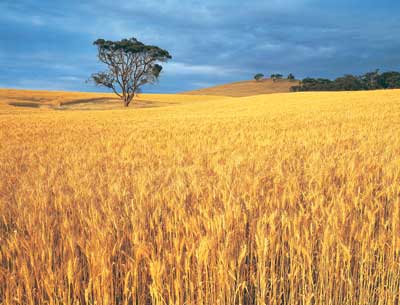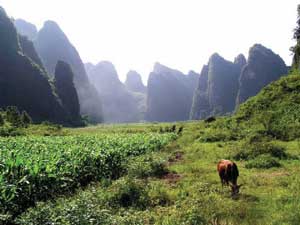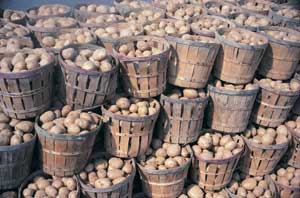| China's Agricultural Revolution |
| http://www.sina.com.cn 2004/02/25 09:24 中国周刊 |
Foreign buyers, food processors seek out Chinese farm produce, while farmers become priority of government reform. A point of view from overseas. ◆By Mark Godfrey Walking into a typical Beijing supermarket is becoming more and more of a Western experience. Large quantities of Western products - imported or produced locally - are available, along with Westernised food products produced by local food companies. At a recent agricultural trade fair meanwhile, purchasers came from around the world to Beijing to place orders for Chinese foodstuffs, praising both their quality and affordability.
Whatever one may say about quantity, quality has often been perceived to be lacking in China's farm produce. The country's principal agricultural commodities are rice, soy beans, wheat and pig meat. The Chinese also produce a bewildering range of other crops, many of them native to China, others grown from imported seed. However, perhaps the greatest drawback to the prosperity of China's farming sector is a lag in technology which has restricted quality and hampered export opportunities. According to the Food and Agricultural Organization (FAO) of the United Nations, China's indigenous pigmeat sector was worth US$ 44 million in 2002, making it the world leader in this sector. Rice is the single most valuable commodity, however, with the total for 2002 running to US$ 180 million. Fresh vegetables, maize, sweet potatoes and wheat are the next most important agricultural products in value terms, earning 133 million, 124 million, 120 million and US$ 89 million, respectively. China lags behind the USA in maize production but leads India as the world's biggest producer of rice. According to the FAO, China's rice output compares well with India's 123 million total for the same product. China is producing huge quantities of quality food, but in a country where two-thirds of the population lives in rural areas, farming is the least popular occupation. More than 900 million people live in China's rural areas. This includes 500 million rural labourers, 180 million of whom are in search of work. Many of these labourers have flooded to booming cities like Beijing and coastal cities, where construction work is plentiful.
Alongside labour surpluses, poor quality and technology shortfalls in its agricultural sector, food safety and organic horticulture have become hot issues in Chinese farming circles. Attractive products are essential if Chinese farmers are to succeed in the tougher commercial world regulated by the World Trade Organization (WTO). Despite drought and the competitive challenges of WTO membership, China's agricultural sector managed to turn in a relatively decent year in 2002. But the country's vast rural market hasn't proved the holy grail for producers which it had promised to be, thus restraining domestic demand. The widening income gap between rural and urban China is probably to blame for sluggish sales in the hinterland. Farm exports hit a record high in 2002, with grain output up by one percent to 475.1 million tonnes and soybean output hitting a historical high of 16.5 million tonnes according to the National Bureau of Statistics (NBS). This was the first time since 1999 that grain output picked up on a year-on-year basis. It's questionable, however, whether the trend can continue. Grain acreage is shrinking partly because of government efforts to reduce the amount of inferior grain strains. Poor air quality and desertification have also seen the government set more farmland aside for afforestation. In its first full year as a member of the WTO, China exported a record 200,000 tonnes of top-grade wheat. Policy makers have allowed a more flexible market-driven grain policy to take hold as producers face up to a much more competitive domestic and global market where quality is key. "Restructuring" has become a buzzword in agriculture policymaking circles. Indeed "reform" and "restructuring" are probably the most used words in the Chinese economic and political press these days. Chinese agriculture needs a massive injection of funds from the central government if the sector is to be able to advance to its full potential. Entry into the WTO was predicted to have a dramatic impact on the country's estimated 800 million farmers. China's agricultural industry has however suffered less impact than expected in its first year as a WTO member, recording instead a sharply growing trade surplus for farm produce. In tandem with its entry into the WTO, China launched a new round of agricultural reforms aimed at "the standardisation of agricultural operations." This is an attempt to address a yawning infrastructural gap between urban and rural areas. Technological innovation alongside improved quality and safety of farm products to meet the challenges posed by China's entry into the global agriproducts market. About two-thirds of China's population lives in rural areas, but agricultural output only makes up 16 percent of gross domestic product (GDP) and 4.9 percent of exports. It is predicted that during the first five years after WTO entry, the country's farming sector will be hit the hardest. Chinese soybean producers remain inefficient, with low yields and sub-standard transportation systems.
Earlier this year, the Chinese Government formally disclosed detailed rules on new tariff quotas for agricultural imports, pledging to reduce average import duty to 17.5 percent by 2004 and to 15.6 percent by 2005 from the current average of 21.3 percent. This should reassure importers who have complained at the pace of Beijing's implementation of WTO criteria. Under the new rules, drawn by the State Development Planning Commission, China has pledged to use a special tariff-rate quota (TRQ) system for key agricultural products like wheat, maize, rice, edible oil and sugar. China is also obligated to cancel export subsidies, keep its subsidy rate for farming at 8.5 percent and abide by WTO agreements on quality control. The subsidy issue could meanwhile become a thorny issue if the Chinese government commits itself to the massive injection of state cash the nation's agriculture sector badly needs. Under WTO rules, China's imports of ten key agricultural products will be decided by the demands of the Chinese market and the tariff quotas promised by Beijing during the negotiations with the WTO. The key products are staples of China's biggest competitors and trading partners: maize6, cotton, palm oil, rape seed oil, rice, woollen yarn, soybean oil, sugar, wheat and wool. In a sensitive compromise made to satisfy keen US, Canadian and Australian exporters, the ten key agricultural imports covered by the tariff quota limit will enjoy a favourable tariff of less than 10 percent. If anything in excess of the quota is imported, it will be subject to a punitive 70 percent. These rules will expire by 2005 when WTO agricultural trade rules are to be renegotiated. Joining the global system for farm produce trading will expose Chinese agriculture to huge risks and challenges, according to Raviprasad Narayanan, until recently Visiting Scholar with the Shanghai Academy of Social Sciences. WTO membership will however also open up the domestic market to competition and huge opportunities for foreign suppliers say Narayanan. It won't be easy for local farmers, he predicts. "This is bringing about a rise in unemployment in the rural areas, and there's an increase in income disparities between the regions that have fared well in the reform period as opposed to the interior regions, especially the western provinces that have lagged behind." Simplification and consolidation of government departments is essential, says Narayanan. "Chinese bureaucracy needs to be radically reformed. The production, distribution, and trading of farm products is currently divided among agricultural, domestic trade and foreign trade departments. An unwieldy administrative system like this will obviously not cope so gallantly with WTO entry." A delegate to the latest Congress of the Peoples, Xu Yanlian from East China's Jiangxi Province, complained that about one-seventh of her annual income is spent on various fees and levies that she and other rural residents are being charged. Contrary to common belief, Chinese farm produce prices are often higher than those on the international market. Domestic prices for wheat, soybean, corn, cotton, edible oil and oil crops, and sugar are 10 to 70 percent higher in China than their international equivalents. Although the prices of meat, vegetables, fruit and seafood products are estimated to be 40 to 80 percent lower than those on the international market, quality standards are sometimes variable. As foreign farm products flood into China, farm incomes will be stunted even further, predicts Narayanan, who sees a rising unemployment rate for farmers relying on primary products like grain, cotton, oil and sugar. Cost-effective American, Australian and European farm products might cause economic traumas for a vast number of domestic farmers, but earnings are already on a downward curve, anyway. The price index of farm products declined from 1996 to 2000, according to figures supplied by the National Bureau of Statistics. The index dropped almost 23 percent during the five years, eating into more than 300 billion yuan (37 billion Euro) of farmers' profits. China's Ministry of Agriculture has conceded that the growing scarcity of arable land and the slide in the grain price are driving farm incomes down, even though Chinese farm exports on average sell at 20 to 40 percent higher than average international market standards. With output surging internationally, Chinese farm incomes would drop regardless of WTO tariff rules. Similarly to many Western agricultural nations, China also suffers from regionalisation problems. Full-time farming accounts for 70 to 80 percent of the per capita income of farmers in the western provinces, compared to a 50 percent average for the rest of the country. Poor economic prospects in the west of the country mean scant opportunities for farmers seeking jobs outside agriculture. Sub-par infrastructure and transport conditions also add to the costs of farmers in the western regions. Since 1998 the Chinese government has sought to stoke the economy with massive bond issues and stimulation of consumption, both measures tilted in favour of urban residents. Per capita disposable income for urban families increased by 23 percent between 1997 and 2000, while rural families saw an increase of less than half that figure. Various government leaders have vowed to address the imbalance, however. In his penultimate speech before retiring from office earlier this year, China's former Premier Zhu Rongji pointed to China's agricultural sector as the one most in need of reform. "We must work energetically to improve the quality of farm products, ensure that crops are grown in areas with the best conditions, and develop industrial belts for production of competitive farm products," said Zhu. Special support would be provided for major grain producing areas. "We need to develop and perfect a certification system for quality standards, an inspection and testing system and a certification system for farm products in order to improve their quality and safety." Rural land policy will be implemented in accordance with the law, Zhu vowed. The Chinese government has marked out several long-term plans for the agricultural sector. Reforms have been divided into "one big" and "six small" projects. Water-efficient irrigation takes priority, followed by rural electrification, potable water, roads, pasture fencing, rural methane and anti-poverty programmes. For farmers migrating to cities for work meanwhile, Beijing promises "Better care and fairer practices for rural labourers." Announcing the government's batch of reforms, Zhu Rongji promised some innovation on previous policy. "We shall strengthen dissemination of agricultural science and technology and promote transformation of research achievements into productive forces. We shall develop intensive processing of agricultural products and improve the management of agriculture." Curbing the decline in farm acreage is another challenge facing China's policy makers. The 2002 China Land and Resources Communique, released by the Ministry of Land and Resources in April this year disclosed that the total area of arable land shrank by 1.32 percent last year compared to figures for 2001. Farmland use should be regulated, agree Chinese agricultural experts, who have called for a supervision system to end the local land grab and demand that the central government establish a nationwide land use registration and supervision system to curb rampant reclamation of land from farmers by local governments. Transferring farmland to property developers and individuals should be curbed, urged a recent article penned by a number of experts in the Hainan-based Transition magazine. Land issues are particularly topical in this fertile southern province. Huge labour and limited land has made China's agricultural production costs extremely high. Using modern entrepreneurial methods, new and efficient agricultural technologies will be able to be more widely disseminated, said Department of Agriculture official Hu Fan. While absorbing rural labourers, processing enterprises will also greatly increase the value of farm produce and spread the use of advanced technologies in rural areas, predicted Fan. Officials have consistently held that China's "household responsibility system" - which allots land to the rural population on a contractual basis - would continue. A major weakness in China's agricultural sector, from a farmer's perspective, is the lack of farmers' representative groups. Lobby groups representing farmers remain novelties in China but have become powerful forces in other key agricultural nations. Though accounting for close to 70 per cent of the country's total population, Chinese farmers are now trapped in a small household-scale peasant economy without industrial organisations to represent their interests. Dips in market demands recently have prompted many enterprises to break contracts already signed and agreed upon with farmers. Farmers however have no collective power with which to combat unfair treatment from government or buyers. Chen Xiaohua, director of the Rural Economic Management Department under the Ministry of Agriculture, meanwhile said the central government is experimenting with farmer co-operatives in several provinces. Perhaps the lack of sectoral voices and farmer power explains the neglect China's agriculture has suffered. Reform in 1978 largely reversed the collectivisation system, with output quotas now apportioned to each farming household under the Household Responsibility System. First implemented as a means of reducing poverty in rural areas, the system was so successful that by 1984 it had become state policy. Under the Household Responsibility System family members may seek employment in urban areas provided someone in the family remains resident locally. Mechanisation and prosperity have both been the result, as indicated by farm machinery manufacturer John Deere's decision to enter a joint venture project in China producing 50, 60 and 75 horsepower tractors for the local market. The further development of Chinese agriculture depends upon better technical capacity. "Agricultural industrialisation is a basic way to solve China's disadvantage in agricultural resources and its laggard technologies," said Fan Xiaojian, China's vice-minister of agriculture. Speaking at the International Conference on Agricultural Science and Technology in Beijing earlier this year, Fan encouraged food processing enterprises to move into rural areas. To this end the government would sign planting contracts with farmers, promised Fan. "This is an efficient way to educate China's many farmers about how to produce goods in accordance with market demands." Meanwhile, the government is moving to merge agriculture research institutions with private enterprise, the vice-minister revealed. Chinese agricultural chiefs have become preoccupied with green agriculture and, with rising living standards; Chinese people are also paying more attention to the origins of food. Foreign "green" trade barriers are threatening the prospects of the country becoming a major exporter of agricultural products in the wake of its entry to the World Trade Organization. Although full of potential, China's trade figures are still eclipsed by Latin America, another large trading block of the developing world. Chinese exports amount to less than 5 percent of world total, while imports amount to only 3.9 percent. According to European economist Eoin Fahy, China's economy must grow at the 2002 rate of 8 percent if its share of world GDP is to reach 5.5 percent by 2014. Agricultural products could prove to be one of the keys to China's development, as has been the case in other developing nations. A great deal of painful reform and restructuring remains to be carried out, however, if Chinese agricultural is to realise its potential and China's farmers are to eventually prosper. Chinese political energies have become centred on rehabilitating China's rural hinterland. The success of these efforts will be essential to China's continued prosperity. Nods of approval and enthusiastic cheque signings at Beijing's recent agricultural commodities fairs suggest that the enthusiasm of foreign buyers for Chinese produce deserves to be translated into the creation of a valuable industry. |
| 【英语学习论坛】【评论】【大 中 小】【打印】【关闭】 |


